Rid your home of unwanted pests with guaranteed service from Eagle Pest Control.
Eagle’s pest control maintenance service is designed to keep you home pest-free by creating a protective barrier around the exterior of your home. We use extremely effective, long-lasting products that are safe to use in homes, schools, day cares, and food service establishments. Our full-service maintenance plans are inclusive of all general household pests. You will have a pest-free environment, both inside and outside of your home or business – Guaranteed.For Service calls and pricing, please call 502-243-1600
Occasional Nuisance Pests
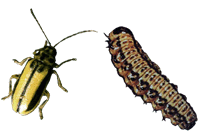
Elm Leaf Beetle
The elm leaf beetle is named for its fondness of elm trees. Both the larvae and adults feed on the leaves, and can cause damage to the tree. Adult elm leaf beetles are around ¼" long, and larvae can get to twice that size.
They are a nuisance pest, since it isn't common for them to actually kill a tree. But in large numbers they can cause severe defoliation. In addition, their droppings can cause staining of painted surfaces and car finishes. Because they look for a protected area to overwinter, elm leaf beetles can end up in your house. To control them on trees, there are a couple of options.
Spraying the tree's foliage is possible if conditions permit. Or if a tree has a history of getting infested, spraying around the base of the tree before the problem gets bad will help to control the beetle in it's earlier state.
Another option is tree injection.
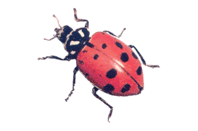
Ladybug or Ladybird Beetle
The elm leaf beetle is named for its fondness of elm trees. Both the larvae and adults feed on the leaves, and can cause damage to the tree.
Adult elm leaf beetles are around ¼" long, and larvae can get to twice that size. They are a nuisance pest, since it isn't common for them to actually kill a tree. But in large numbers they can cause severe defoliation.
In addition, their droppings can cause staining of painted surfaces and car finishes. Because they look for a protected area to overwinter, elm leaf beetles can end up in your house.
To control them on trees, there are a couple of options. Spraying the tree's foliage is possible if conditions permit. Or if a tree has a history of getting infested, spraying around the base of the tree before the problem gets bad will help to control the beetle in it's earlier state.
Another option is tree injection.
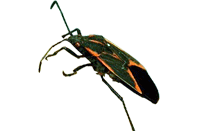
Boxelder Bug
Boxelder bugs are named for their fondness of boxelder trees. Aside from boxelder trees, they will also congregate on maple, cherry, or ash trees - preferring the seed or pod bearing members of the trees they infest.
These bugs are around ½" long, and colored distinctively black with red markings. In large numbers they can be quite a nuisance as they have the potential to bite, but don't do any real harm to the trees they infest.
When they decide to overwinter, they can get into your house. Inside, their fecal matter will leave red stains and crushing them causes a foul smell.
Tree removal is an option, but doesn't always solve the problem as these pests can infest other things. Ideally, the problem can be dealt with before it gets out of hand. This would mean clearing egg laying sites, like piles of brush or rocks, and spraying trees before all the bugs hatch out.
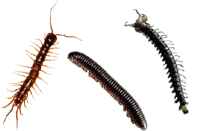
House Centipede and Millipede
Centipedes and millipedes are named for their large number of legs. Millipedes usually have more legs, with 2 pairs per body segment - whereas centipedes only have one.
They both range in size, anywhere from 1/16" long up to several inches. Centipedes can run very fast, and millipedes will curl up in a ball when disturbed.
With a preference for moist areas you can find them under rotten logs, in mulch, or in other organic matter. When they get into your home, they look for damp areas like basements or bathrooms. If a centipede is large enough, it can bite and inject venom which feels about like a bee sting.
Millipedes feed mostly on plant matter and don't bite, but can excrete a stinky fluid some people are allergic to.
In nature centipedes are a beneficial part of the food chain, feeding on other insects. This means they also eat other insects inside, which can be looked at as good or bad.
They provide free pest control, but are another pest in themselves. So generally keeping your home free of other pests can help to keep centipedes from moving in.
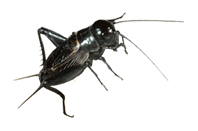
Field and House Cricket
Field and house crickets are the most common crickets to enter a house.
Less than 1" long, the field cricket is darker in color than the house cricket. Crickets are nocturnal, feeding and chirping when it's dark out. Outside they can live in woodpiles, garbage heaps, or other moist and protected areas.
The house cricket particularly likes warmth. Though both crickets can potentially eat soiled clothes, field crickets are more of an agricultural pest than an indoor one.
They have been known to travel in swarms and destroy various kinds of wheat and vegetable crops. The house cricket is raised to feed pets, and commonly is a nuisance when it escapes. In this case spraying outside would not be necessary, and various baits can be used. Otherwise, crickets originating outside can be controlled through yard cleanup and spraying a barrier around the home.
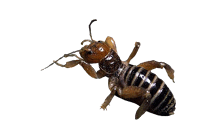
Jerusalem Cricket
The Jerusalem cricket, or potato bug, is a large and scary-looking insect. Sometimes 2" long or more, it's one of the largest insects found in this area. Despite their appearance, they are considered harmless. With their large jaws they can bite, but rarely do - and they aren't poisonous.
Jerusalem crickets are nocturnal, and live mostly underground where they feed on roots or other insects. They don't eat enough to cause damage in gardens, and are an important part of the food chain for owls and hawks.
If one happens to wander close to your house, catching and releasing them is the best way to control them.
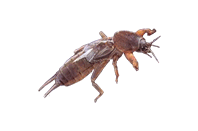
Mole Cricket
The mole cricket is named for it's mole-like looks and behavior. They are around 1" long, with scoops for front legs.
Like other crickets they are nocturnal, and mole crickets are attracted to lights at night. Mole crickets burrow into light, sandy soils where they feed on plant roots or insects.
They are an agricultural pest, attacking turf grasses and various fruits and vegetables - but occasionally get into the house.
If they are suspected outside, spraying a lemon dishwashing soap solution on the ground will cause them to come to the surface.
When they move to the surface it makes them easier to see, and also makes pesticide treatments more effective. They have resistance to some pesticides, but there are still others that work.
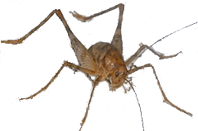
Cave Cricket
These large (1 1/2"), wingless crickets are common in dark, moist places like caves and basements where they scavenge for decaying plant and animal materials.
Despite their fearsome appearance, they are harmless.
Cave crickets will commonly live in dark cellars and in crawlspaces, but they cause no harm and prefer to stay out-of-the-way of people.
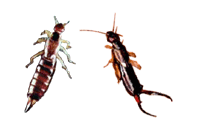
Earwig
The earwig, or pincher bug, doesn't really live up to either of its names. The name earwig comes from and old myth that these insects crawl into people's ears and get into their brain. Pincher bug implies that they could hurt you - which isn't the case. Earwigs can vary in color and markings depending on the species, and can be up to 1" long.
Males and females can be told apart by their pinchers. Male pinchers resemble outsider calipers, while females are smaller and close together.
They are nocturnal, living in moist, sheltered areas during the day. At night they come out to feed on a variety of plants and insects.
Frequently they eat garden plants, making them a nuisance. When there are enough of them outside some can make their way into your home, and have the potential to smell bad if alarmed or crushed.
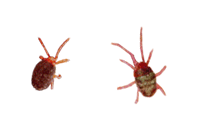
Clover Mite
The earwig, or pincher bug, doesn't really live up to either of its names. The name earwig comes from and old myth that these insects crawl into people's ears and get into their brain.
Pincher bug implies that they could hurt you - which isn't the case. Earwigs can vary in color and markings depending on the species, and can be up to 1" long.
Males and females can be told apart by their pinchers. Male pinchers resemble outsider calipers, while females are smaller and close together. They are nocturnal, living in moist, sheltered areas during the day.
At night they come out to feed on a variety of plants and insects. Frequently they eat garden plants, making them a nuisance.
When there are enough of them outside some can make their way into your home, and have the potential to smell bad if alarmed or crushed.
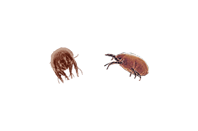
House Dust Mite
House dust mites are tiny, transparent pests who feed mostly on dead skin cells shed by humans or pets. These mites are too small to be seen with the naked eye, but are present in most every house in some degree. With skin cells being their favorite food, they concentrate in areas like beds or stuffed furniture. Carpets usually only house a fraction of the dust mite population.
Dust mites themselves don't cause a problem, as they don't bite. The problem comes from the skins they shed, and their excrement. These by-products are the main cause of people's breathing related allergies inside.
Infestations of dust mites can get so high a single bed can contain millions of them, and 10% of the weight of a pillow can be dust mite skins and feces. Pesticides aren't used for dust mite control, but there are some things that can be done to help.
They need moisture and food to live, so anything that can be done to deprive them of those 2 things will be effective. Dehumidifying rooms, airing out bedding, washing blankets, replacing natural pillows with synthetic ones, vacuuming, and covering mattresses with plastic covers are all things that will cut way down on dust mite populations.
Remember, it's what the dust mites give off that causes the problem. So cleaning up their microscopic waste is important, as well and controlling the number of adults so more waste is not produced.
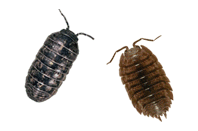
Pillbug and Sowbug
Pillbugs are sowbugs are similar creatures who live outside. The easiest way to distinguish them is pillbugs can roll into a ball (another nickname for them is "rolley poley"), whereas sowbugs can't.
Additionally, sowbugs have 2 tails sticking out of their backs and pillbugs don't. They have the same habits, living in moist protected areas and eating decaying matter. They are crustaceans not insects, and breathe through a sort of gill setup. This means they can't leave moisture for very long, and will die in the house if they don't find it.
Neither one has the ability to bite, and are both helpful is breaking down decomposing material.
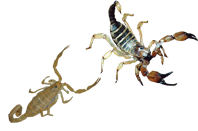
Scorpion
Scorpions include many different species belonging to the order "Scorpiones", which is where their common name comes from.
They can be several inches long, and vary in color. Although famous for their stingers and feared by many, the scorpion isn't a big problem in this area.
Their stingers are used to kill insects for food, but if needed can also be used for defense. A scorpion sting is usually similar to a bee sting, but can vary depending on the size and species of the scorpion. Also, scorpions have the ability to regulate how much venom they inject - making it possible for different stings to have different amounts of toxicity.
Most species found in the United States aren't potentially lethal. But there is at least one species that has a neurotoxin in its venom that can cause respiratory failure, mostly to children. If you do get stung wash the area with warm soapy water, apply ice to reduce the swelling, and watch for symptoms. Most people have a rapid recovery from the stings.
If strange symptoms occur - see a doctor! Some people are allergic to the venom and need special treatment.
Scorpions are nocturnal, hiding during the day to conserve moisture. Occasionally they crawl into houses at night and then hide in things during the day.
You can imagine the problem if they chose to hide in a shoe, or other place where they can surprise people.
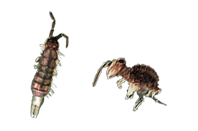
Springtail
Springtails are very small insects named for their tails, which enable them to jump relatively high. They are around 1/16" long, and difficult to see with the naked eye. However, under magnification they look almost like a shrimp with their humped back Their ability to jump and small size makes them sometimes confused with fleas, though they don't bite.
Springtails live mostly outside in damp or decaying conditions. They need moisture to survive and feed on things like decaying matter, mold, and fungus. There are thousands of them in soil and decaying leaves, but they usually go unnoticed. When they get into moist areas of the house, or in house plants is when they become a problem.
Usually drying out the moist conditions, and cleaning up the springtails will be enough to control them. If potted plant soil if heavily infested, repotting into new sterile soil can be a quick remedy.
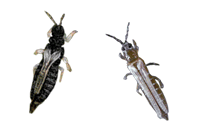
Thrip
Thrips are small plant pests, under 1/16" long. They have a slender body, and can be a variety of different colors. Many species exist, some with wings and some without.
Thrips can cause unsightly damage to plant leaves and flowers, but can only seriously damage young plants. With their small size and tendency to hide inside plant crevices, they can be hard to detect. Look for damage to plants; black specks, scarring, or distorted/discolored parts of plants can all be signs of thrips feeding.
A good way to find specimens if they are suspected is to hold a plant over a piece of paper, and shake it to catch the pests that fall of. Not only can thrips appear in large numbers, some can bite - giving them the potential to be troublesome pests when people are present, especially around grassy areas.
If necessary, pesticides can be used in gardens or lawns to control thrips. Careful attention must be paid to using pesticides safe to the plants being treated. If they get in your house, thrips can infest indoor plants. Inspecting flowers and plants before bringing them inside will help.
A weak soap water solution can be effective in controlling thrips on houseplants, and should be applied weekly until they aren't seen.
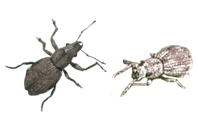
Weevil
Weevils are sometimes called "snout beetles", not a bad nickname for them - as they are basically beetles with longer snouts. There are many types of weevils that attack plants, all varying in size and color. Typically they are darker brown or black, with or without spots or markings. Weevil larvae are subterranean, feeding on the roots of plants and seldom seen.
Adult weevils are nocturnal. During the day they hide in soil or debris, and come out at night to feed on all kinds of plants. Depending on the species, they will eat various things including berry vines, flowers, alfalfa, clover, or even woody landscape plants. The damage left from them chewing on leaves looks like half-circle bites taken from around the outside edges. If they are attracted to wild plants, plant removal can be helpful and might be a consideration. If they are suspected to be in your garden, there are several ways to trap and identify them. Spreading sticky trap material around the stalks of more mature plants is one way.
Another method is to wrap pieces of burlap around the base of the plants. Weevils love to hide in the folds of burlap during the day, and can be shaken out to remove and identify them. Something else to try is shallow pans of water, as weevils seem to be attracted to them and will drown when they crawl in. Many types of control are available for infested plants.
Weevil baits, sprays, nematodes, or diatomaceous earth (abrasive to the weevils) can all be used. Weevils sometimes enter homes, probably to overwinter.
Additional resources are available to assist you in identifying and controlling insects.
Insect Identification
With over 1 million identified species of insects and spiders in the world with many more still awaiting discovery. Use Insect Identification categories to discover your species.
Pest World
For expert pest control tips and resources surf to Pest World.
Pest World for Kids
For fun pest facts and kid-friendly bug and insect research, head to Pest World for Kids.
